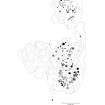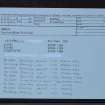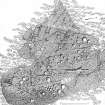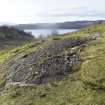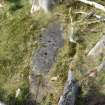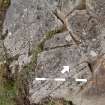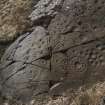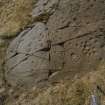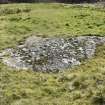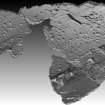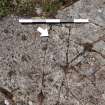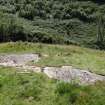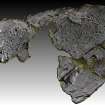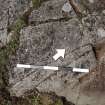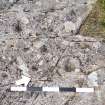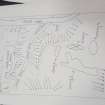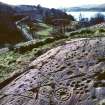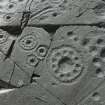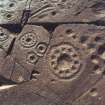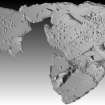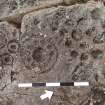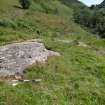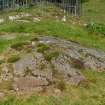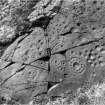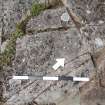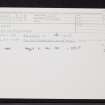Ormaig 1
Cup And Ring Marked Rock (Neolithic) - (Bronze Age)
Site Name Ormaig 1
Classification Cup And Ring Marked Rock (Neolithic) - (Bronze Age)
Canmore ID 22860
Site Number NM80SW 8
NGR NM 82231 02707
Datum OSGB36 - NGR
Permalink http://canmore.org.uk/site/22860
- Council Argyll And Bute
- Parish Kilmartin
- Former Region Strathclyde
- Former District Argyll And Bute
- Former County Argyll
NM80SW 8 8222 0270.
NM 822 026. At least four sheets of rock, bearing cups, cup-and-rings, and complex designs, to which have been added "John Campbell 1874" and "1877", occur up the centre and west side of the ridge running north from the river at Ormaig.
M Campbell and M Sandeman 1964.
Only three outcropping rocks with markings were found in this area at NM 8222 0267. 'A' measures 2.5m x 1.0m. As planned. 'B', 9.0m to the NE, measures 2.0m x 0.5m and bears three cup and ring marks and at least 11 cups. 'C', 3.0m NE of 'B', measures c. 1.0m square; it bears 5 cup and ring marks and about 15 cups.
Surveyed at 1:10,000.
Visited by OS (R D) 11 March 1970.
NM 8222 0267; A magnificent series of over 200 carvings including cup and cup-and-ring marks, many in "mint" condition have been uncovered by Miss Campbell and the Mid Argyll Society.
Information contained in letter from R W B Morris to OS, 22 July 1973.
NM 82226 02688 There are at least three groups of cup and ring marks within an area of c 10m by 10m. Site identified during a field survey carried out by GUARD in 2003.
Heather F James, 2003 (RCAHMS MS 2371, no.20)
NM 8222 0270 A programme of archaeological works was carried out at Ormaig cup- and ring-marked site in Argyll in July and August 2007. Through hand excavation the extent of the site was determined and previously noted but subsequently 'lost' decorated exposures 4, 5, 6 and 7 (the former recorded by the RCAHMS. in 1985 and the latter recorded in Morris 1977) were re-located and recorded. Newly exposed rock art was recorded using a variety of methods including scaled plan, tracing and laser scanning. The lowermost exposure, Exposure 1, was cleaned of
moss and grass; Exposures 2 and 3 were not cleaned, as the roots of the moss cover appeared to penetrate the rock surface.
Data on the vegetation covering the rock art and the geology into which the rock art had been carved was also collected to inform options for the long term management and conservation of the site and other similar rock art sites in Mid-Argyll.
Archive deposited with Kilmartin House Museum
Funder: British Academy, The Society of Antiquaries of Scotland and the Dalriada Project
Clare Ellis, 2007.
Field Visit (June 1985)
This cluster of cup-and-ring marked rock outcrops, which lies partly within a forestry plantation and partly in a clearing, is situated on the W shoulder of Creag Mhor 330m S of Ormaig farmhouse and 90m E of the bridge over the Eas Mor. There are two principal groups of marks (1-2), as well as four lesser sets (3-6), and they are described here as they occur from S to N (Campbell and Sandeman 1964; Morris 1973).
(1) The lower of the two major exposures is a gently sloping rock-sheet on which the decoration is divided into two sections; that to the W has been open to the elements for many years, while the other was only revealed in 1974, and the carvings on it are unusually fresh, with individual peck-marks clearly visible. The W section bears seven cups with single rings, at least fifteen plain cups and several lengths of grooving, with a marked concentration at the W end. Besides the ancient carving, there are some modern graffiti, which include the names John Campbell 1874 and Archie Campbell 1877. On the lower part of the sheet there is a mass of carving comprising four cups with double rings, twenty-seven with single rings, numerous plain cups (some with gutters), and several channels, including a parallel group of three, which lie towards the E end of the sheet. The most interesting feature of this group, however, are the three marks sometimes referred to as 'rosettes'. They comprise a cup-and-ring marking with a circle of pits or small cups lying between the central cup and the surrounding ring. In addition to the three complete rings of pits, one of the cups with two rings has half of its inner ring formed of similar pits, but in this case it is not clear whether it was deliberate or marks an intermediate stage in the completion of a normal ring.
(2) At the E edge of the clearing a short distance N of (1), there is a steeply sloping finger of bare rock; it is much weathered and fractured, but is so profusely decorated that the entire surface appears to have been modelled. Amongst the concentration of closely spaced cups, rings and channels, there are two marks that are especially worthy of note. Firstly, at the bottom left of the outcrop, there is a cup-and-gutter surrounded by a circle of pits (similar to the rosettes in (1) above), which in turn is enclosed within multiple rings, the inner and outer of which lead into a guttered cup and another ring respectively. The second mark lies 1.1m above the first and comprises seven short parallel grooves; this is a most unusual feature for Scottish rock art.
(3) An outcrop immediately W of the top of (2) bears two groups of marks both badly fractured and weathered. The eastern comprises twelve cups with single rings and at least seven plain cups, while to the W there are four cups with single rings and six plain cupmarks.
The remaining three groups all lie in the afforested area and are partially obscured by vegetation:
(4) About 2m NNW of (3), there is an outcrop bearing six plain cups measuring up to 50mm by 20mm.
(5) On an outcrop 1m N of (4), there are five cups with single rings, nine cups (three with gutters) and numerous channels.
(6) Some 4m N of (2), there is an outcrop which bears ten weathered cupmarks measuring up to 60mm by 15mm.
Visited June 1985
RCAHMS 1988
Measured Survey (June 1985)
RCAHMS surveyed Ormaig cup-and-ring markings on June 1985 with plane-table and alidade producing a plan at a scale of 1:100. The plan of the cup-and-ring markings was redrawn in ink and published at a scale of 1:250 (RCAHMS 1988a, 119).
Laser Scanning (1 August 2007 - 3 August 2007)
NM 8222 0270 On behalf of Kilmartin House Museum, a laser scan survey of the rock outcrops at Ormaig was undertaken between 1-3 August 2007 using a combination of medium range and high-resolution short-range laser scanning. Coverage of around two thirds of the carvings was achieved during the survey, including five previously unrecorded exposures.
Archive to be deposited with RCAHMS.
Funder: Kilmartin House Museum.
Graeme Cavers and Gemma Hudson, 2007.
Excavation (July 2007 - August 2007)
NM 8222 0270 A programme of archaeological works was carried out at Ormaig cup- and ring-marked site in Argyll in July and August 2007. Through hand excavation the extent of the site was determined and previously noted but subsequently 'lost' decorated exposures 4, 5, 6 and 7 (the former recorded by the RCAHMS. in 1985 and the latter recorded in Morris 1977) were re-located and recorded. Newly exposed rock art was recorded using a variety of methods including scaled plan, tracing and laser scanning. The lowermost exposure, Exposure 1, was cleaned of moss and grass; Exposures 2 and 3 were not cleaned, as the roots of the moss cover appeared to penetrate the rock surface.
Data on the vegetation covering the rock art and the geology into which the rock art had been carved was also collected to inform options for the long term management and conservation of the site and other similar rock art sites in Mid-Argyll.
Archive deposited with Kilmartin House Museum
Funder: British Academy, The Society of Antiquaries of Scotland and the Dalriada Project
Clare Ellis, 2007.
Laser Scanning (25 March 2014 - 27 March 2014)
A laser scan survey was carried out at Ormaig prehistoric rock art in March 2014 for the purposes of conservation management. The survey was the second such survey to be carried out, with data collected in 2007 providing a baseline record to which the 2014 data was compared. Significant changes to the site were noted, largely due to moss and lichen growth over the exposures caused by the removal of forestry cover in the surrounding area.
Information from Graeme Cavers (AOC), 24 April 2014
OASIS ID aocarcha1-193116
Note (22 July 2019)
Date Fieldwork Started: 22/07/2019
Compiled by: Ulterior Motifs
Location Notes: Ormaig 1 is located at NM 82231 02707. The panel is approximately 5m SW of Ormaig 2 and 10m S of Ormaig 3. The site is signposted and accessible by a footpath from the forestry road approximately 80m to the W of the site. The panel lies in its original location on a sloping hillside with a SW aspect. The hillside was formerly forested but the area containing the panels is now felled (surveyed in July 2019). The panel has clear views to the NW over Loch Craignish.
This record originally recorded multiple panels at Ormaig which have, as part of the Scotland's Rock Art project, been separated into four distinct panels. This record relates to one of the largest and the most southerly of the panels which is most famous for its distinct rosette style motifs.
Panel Notes: The panel is located within it's original context in the landscape, on a sloping rocky outcrop. The main rock surface has a SW aspect with the majority of the carved surface orientated to the W. The panel is medium grain schist with a hard compactness. It has fissures, natural hollows and bedding planes visible on the surface. The panel is approx. 7.8m long, 5.1m wide and has a maximum height of 1.1m and has two main surfaces. The surfaces of the panel have been carved with numerous motifs, including: c.113 regular sized cupmarks, nine large cupmarks, one set of two conjoined cupmarks, five cups with a tail, one cup and ring with a tail, two cups with two complete rings, 14 cups with partial rings, 15 cups with single complete rings, three rosettes (one large; two smaller), one cup with a complete inner and an incomplete outer ring, 9 grooves, two sets of parallel grooves and two oval shapes.
Watching Brief (8 January 2020 - 9 January 2020)
NM 82216 02689 A walkover survey and a watching brief were undertaken on the route of a new deer management/access track adjacent to the Scheduled rock art site (SM5488) of Ormaig (Canmore ID: 22860: SM5488). The walkover was carried out on 8 and 9 January 2020 and recorded two structures and two clearance cairns which had probably previously been recorded in 2007. No features or deposits of archaeological or historical significance were discovered during the watching brief.
Funder: Forestry and Land Scotland
Clare Ellis − Argyll Archaeology
(Source: DES Vol 21)









































